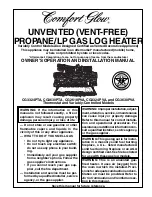
17
Checking the Draft
After successfully lighting the water heater, allow the unit
to operate for 15 minutes and check the drafthood relief
opening for proper draft. Make
sure all other appliances in
the area are operating and
all doors are closed when
performing the draft test. Pass
a match flame around the relief
opening of the drafthood. A
steady flame drawn into the
opening indicates proper draft.
If the flame flutters or is blown
out, combustion products are escaping from the relief
opening. If this occurs,
do not operate the
water heater until proper
adjustments or repairs
are made to the vent
pipe system and/or air
supply requirements.
Burner Flames
Inspect the burner
flames through the viewport and compare them to the
drawings in Figure 18. A properly operating burner should
produce a soft blue flame. Blue tips with yellow inner cones
are satisfactory. The tips of the flame may have a slight
yellow tint. The flame should not be all yellow or have a
sharp blue-orange color. Contaminated air may cause an
orange colored flame. Contact a qualified person if the
flame is not satisfactory.
Stacking
Stacking occurs when a series of short draws of hot water
(3 gallons or less) are taken from the water heater tank.
This causes increased cycling of the burner and can result
in increased water temperatures at the hot water outlet. An
anti-scald device is recommended in the hot water supply
line to reduce the risk of scald injury.
Emergency Shut Down
IMPORTANT: Should overheating occur or the gas supply
fails to shut off, turn off the water heater’s manual gas
control valve and call a qualified person.
Figure 17
Match
Relief
Opening
Drafthood
Figure 18
Flame Characteristics
Tips may have
a yellow tint
Yellow inner
cones are
satisfactory
Correct flame
soft blue
Water Temperature Regulation
The thermostat is adjusted to the pilot position when it
is shipped from the factory. Water temperature can be
regulated by moving the temperature dial to the preferred
setting. The preferred starting point is 120°F. Align the knob
with the desired water temperature as shown in Figure 19A.
There is a hot water scald potential if the thermostat is set
too high.
IMPORTANT: Adjusting the thermostat past the 120°F bar
on the temperature dial will increase the risk of scald injury.
Hot water can produce first degree burns within:
120°F (49°C) more than 5 minutes
130°F (54°C) at 20 seconds
140°F (60°C) at 3 seconds
150°F (66°C) at 1-1/2 seconds
NOTE: During low demand periods when hot water is not
being used, a lower thermostat setting will reduce energy
losses and may satisfy your normal hot water needs.
If hot water use is expected to be more than normal, a
higher thermostat setting may be required to meet the
increased demand. When leaving your home for extended
periods (vacations, etc.) turn the temperature dial to the
vacation (VAC) setting. This will maintain the water at low
temperatures with minimum energy losses and prevent the
tank from freezing during cold weather.
Figure 19A
Honeywell Gas Valve/Thermostat
Settings
Gas Control/Temperature Knob
Status
Light
Igniter
120°
Mark
120°
Mark
150°
Mark
Index
Mark
Burn Hazard
Do not touch vent.
Doing so can result in burns.
WARNING
Water temperature over 125°F can cause
severe burns instantly or death from scalds.
Children, disabled and elderly are at highest
risk of being scalded.
Feel water before bathing or showering.
Temperature limiting valves are available.
WARNING












































